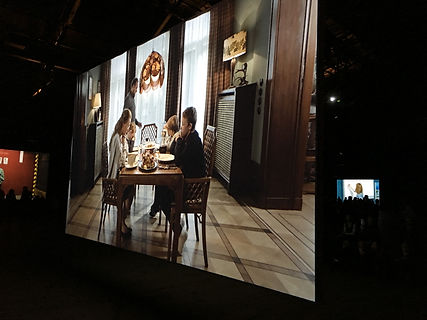Karen, Bruce, and I went to *Manifesto* at the Park Avenue Armory on 1/6. It's a film installation by artist Julian Rosenfeldt. He chose nineteen artistic movements, gathered their manifestos and writings by their creators/practitioners, and made thirteen films, more or less settings of the texts. The star of every film was Cate Blanchett. The films were screened on thirteen screens around the enormous Park Avenue Armory.
These are the subjects of the thirteen films and pictures where applicable:
1. Prologue: burning fuse
[no photo]
2. Situationism: homeless man
3. Stridentism / Creationism: tattooed punk
4. Fluxus / Merz / Performace: choreographer
5. Dadaism: funeral speaker
6. Futurism: broker
7. Pop art: conservative mother with family
8. Suprematism / Constructivism: scientist
9. Conceptual art / Minimalism: newsreader and reporter
10. Architecture: worker in a garbage incineration plant
[no pictures]
11. Surrealism / Spatialism: puppeteer
12. Vorticism / Blue Rider / Abstract Expressionism: CEO at a private party
13. Film / Epilogue: teacher
My favorites were the funeral speaker and the choreographer. The funeral speaker was hilarious, the text on Dada was a scream. The line I remember: "Dada is still shit, but we want to shit in different colors." The hilarity (and Dada impact, actually) of the text was heightened by the graveside setting, and Blachett's absolutely straight and impassioned delivery. And the choreographer - - what's not to like about Blanchett playing a Russian choreographer, doing a ballet with dancers dressed as aliens? Karen said, "I feel like I've come closer to understanding Fluxus."
Karen and Bruce went back a couple of days later and spent another two hours seeing everything. Bruce really loved the conservative mother saying grace, and her prayer was a piece by Claes Oldenburg about the art he wants to see. A highlight of this film was watching Blachett carve a small turkey using pruning shears. BTW the father and sons in that film are played by Blanchett's husband and sons.
Karen and Bruce and I entered the space and watched the homeless man film from start to finish (each film is about eleven minutes long). Then we moved on to the choreographer. There was a moment in the choreographer film when Blanchett faced forward and there was a close-up of her head and shoulders. She was intoning the text on a single note, like it was a chant. The homeless man had done this, too, but I hadn't noticed it. I realized, during the choreographer film, that all twelve of the films were paced so that all twelve characters were chanting at the same time, each on a different note and each intoning different texts, and there was a little ramping up and ramping down at the beginning and end (all twelve didn't start and stop at the same moments). It was one of the most genius moments in the experience, it's the thing that made it not just twelve screens being screened at the same time - - it made it a total experience. Here's a photo of the CEO in this moment:
And the puppeteer, with the newsreader on the right:
And the puppeteer, with the choreographer on the left:
I had so many thoughts and observations. At first it reminded me of Matthew Barney, the contemporary artist who made the Cremaster film series and other masterpieces in petroleum. The films had a similar gorgeous design, peculiar subject matter, and the personal visionary voice of the artist was equally strong. But the whiff of Barney wore off pretty soon, Rosenfeldt is really doing his own thing, and no one else could do it.
Every work of art is made of choices and decisions, and I would guess this one had more than most. How did he choose the nineteen artistic movements? The texts he used to represent them? The specific excerpts from the texts? How did he come up with the settings for these texts? How did he choose the locations (the locations were incredible)? When did Blanchett come into the project, and how much of a collaborator was she?
Blanchett was astonishing. Though, as Karen said, her performance (or, really, performances) weren't so striking in themselves because they were so effortlessly woven into the total artwork, the total experience. I got the feeling that she was thrilled to be doing something so completely original and challenging, not the world's millionth production of *Uncle Vanya* (and it must be said, that production of *Uncle Vanya* that she did at City Center in 2012 was pretty damn dull).
I was reminded of a conversation I had with Audrey Highton back in 1995, she's a soprano I knew back in Wisconsin. I ran into her in the music library a few months after the premiere of my eight-minute opera *Ladies' Voices.* She told me how much she enjoyed it, and I thanked her. She didn't know I was a composer and asked me what it was like composing versus performing. I told her it was much more gratifying to create something rather than interpreting someone else's work. She got quietly huffy (as only Audrey could) and said, "Well, interpretation is creative. A Schubert song is just ink on a page until someone performs it." Well YES.
I thought of this Audrey Highton conversation because it seemed like Blanchett, as an actor, was doing something more than an actor is typically called on to do. She was part of the creative force of the project, not only an interpreter.
LOVE, Chris

























